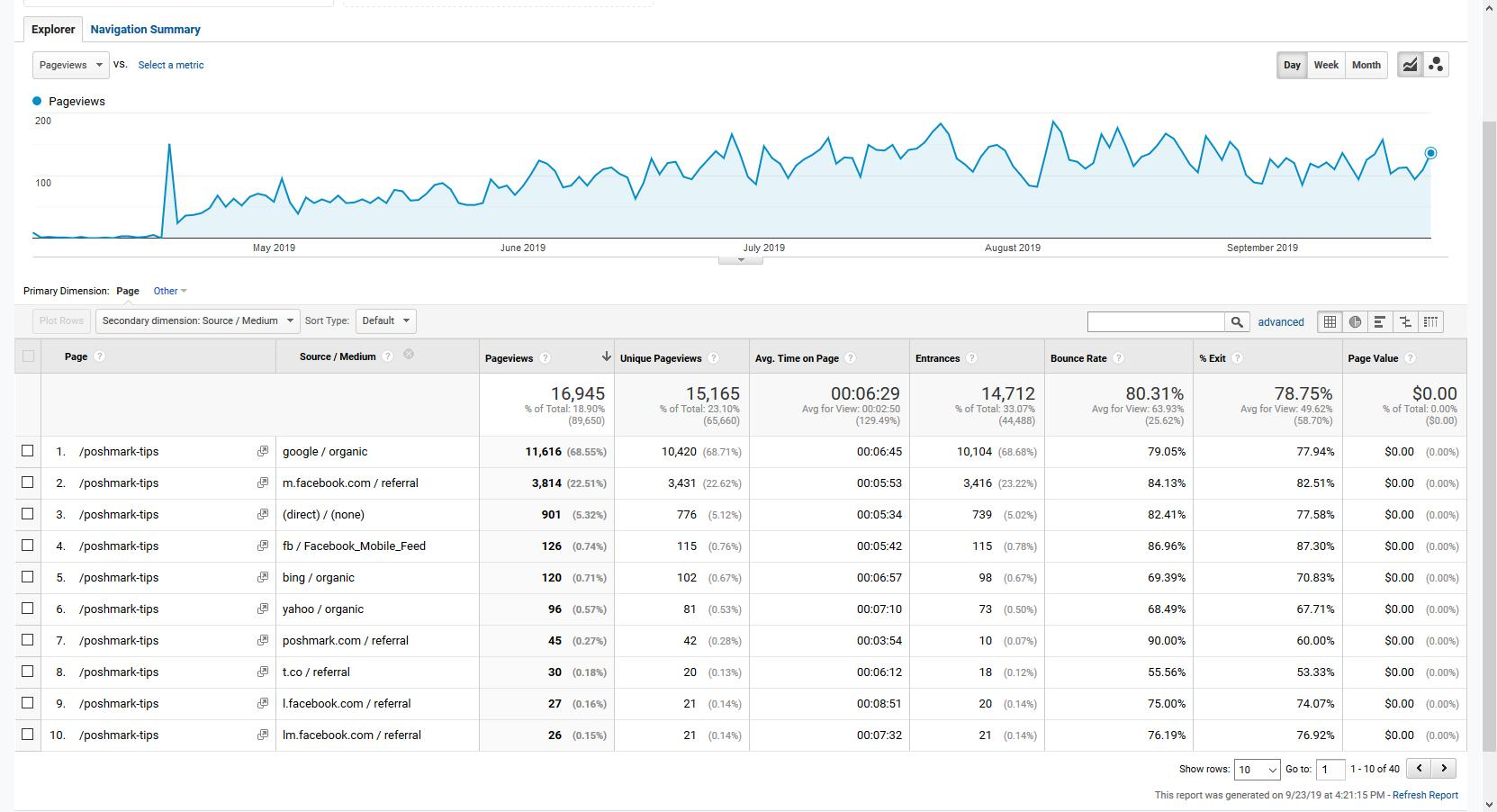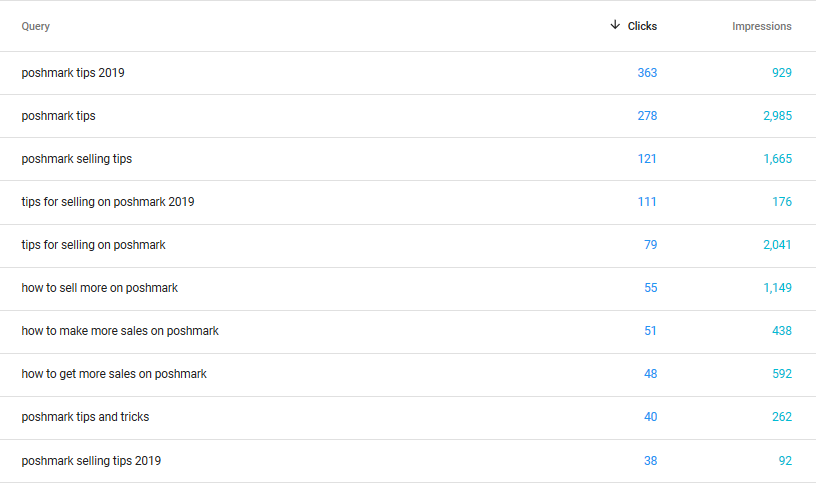This was a happy accident, and I wouldn’t have really discovered the power of it had Harry not pinged me about some of my SEO tactics.
He’ll be writing something over on marketingexamples.com about it. Definitely check it out!
Okay, it wasn’t an accident. I talked about it the “External Traffic” section of my last article on SEO.
Here’s the hook: I got an article that had essentially 0 organic traffic in the first month it was published to 2200 clicks per month by spending ~$2500 in FB ads.
At roughly $0.63 per click (from the FB ads), that means I now get $1386 in free traffic every month from Google.
So, I basically paid $2500 once to get $1400 in traffic every month. I call that a win.
I don’t think you need to spend $2500 to see these results. You can probably spend less and see good success.
I’ll show you how paid traffic can boost your organic traffic massively. Step by step.
Why does this work?
The underlying premise is that Google needs to know how your content performs when traffic arrives.
Say you write a great article that’s an incredible piece. It’s got 5000+ words, explains a topic/solution beautifully, and should probably be published as a small book.
When you hit ‘publish’, and Google scrapes your site, they’ll see this article. They think, “Great! I’ll index it so we can keep an eye on it.”
And then, crickets. One month goes by. Two months goes by. Surely Google has read the article, they know what it’s about, and they know what keywords it should rank for, right?
Yes, but here’s what they don’t have: data.
Google doesn’t care if you’ve written the best content in the world. They care about the experience of the traffic that comes to your content.
They look at the page speed, the page weight, the mobile friendly-ness, the scroll distance, the average time on the page, etc.
Those are the only factors that Google has to indicate whether or not your content is worth promoting for organic traffic.
When there’s no traffic to your content, Google has no way of evaluating that data.
So, it’s a bit of a fly-wheel. You need a traffic jump-start to get Google comfortable with promoting you in Google Search.
Here’s the proof
Alright, I know, this guy is just spouting off about you spending money to make money. Let’s be real.
I published the article on March 8th.

Here’s how much I spent on ads. I started them on April 18th and ended them on September 1st.

Here’s my traffic for the post. This graph starts on April 1st (almost a month after it was published). You can see it was getting almost zero traffic until I started pushing ads to it.

And lastly, the most important screenshot. My organic traffic for the post. As you can see, it started out at a big fat zero clicks. It’s now getting roughly 100 clicks per day.

That’s about the extent of the keyword. It’s a 1000/month search in Ahrefs. That, plus long-tail clicks, gets my total traffic for the post. Sounds about right.
Here’s some of the top keywords the post ranks for:

As you can see, the top keywords account for 1184 clicks. There’s been a total of 8480 clicks on the article.
That means there’s lots of long-tail action going on (and if you play your cards right, that’s where the money is!).
Who is this for?
This tactic is for people who have a brand-new site with content, or who have a site that has great content but doesn’t have any organic reach (small email list, social presence, etc.).
If you’re someone who has a large audience, and can get a few thousand targeted visitors to a new blog post, this isn’t necessary. Just use your audience to get that traffic.
For large publishers and companies, they have an audience that gives them a jumpstart. They just send out an email or notification and it’s done.
For you and me, we don’t have that luxury. We need to get the traffic from somewhere else.
Luckily, we can spend money in exchange for traffic. FB ads, Twitter ads, Google ads, etc.
Like I said above, I don’t think you need to spend $2500 to see these results. I basically put FB ads on autopilot spending $20/day for around 4 months.
But, if your content isn’t worth investing some money into traffic, then it might just not be worth it at all.
The process is simple
Here’s the steps:
- Write awesome content.
- Do your keyword research!
- Publish it.
- Index it.
- Promote it.
- …
- Profit.
Okay, there’s a little bit more nuance than that, but it’s not magic. Simple stuff.
The major piece to the puzzle is making sure your content is optimized for the metrics that matter the most to Google. Things like average page-on time, and page speed.
If you have good metrics when you promote your content, then Google will handle promoting you in search.
There’s some things you can do with your ads that will help you get better quality traffic that actually wants to read your content and give Google good data.
How to advertise content
Once again, this isn’t rocket science. It’s pretty simple. But there’s some things you should definitely do.
First of all, you should be using any organic audience that you’ve already built up. Even if it’s 100 people. That’s a great start.
You’ll want to put out your content to your email list, to your social media followers, and to anyone else you can think of that would be a good fit for the topic.
Next, you need to decide where you want to promote your content.
FB is relatively cheap. At $0.63 per click, that’s a pretty good deal. Google AdWords is much more expensive (though much better at getting specific audiences to your content), and Twitter ads are meh. Try them all if you want.
I went with FB because I could build a lookalike audience with the email list of users of my product.
Once you make a lookalike audience, you’ll get access to a FB audience of around a million people that are somewhat similar to the people who already engage with your stuff.
If you don’t have users of an app, this could be your current email list. If you don’t have an email list, don’t worry about it. You can just use the FB targeting demographics to dial into the right audience.
Promoting content is easy, because it’s a light-weight ask. You’re not asking people to buy your product, you’re just asking them to read the awesome stuff you wrote for them. Sounds pretty nice.
Put a catchy caption on the ad, a catchy title, and slap some money on it.
You could run it at $10 a day for a month. That’s $300. Or roughly 200 clicks.
Is that enough for Google to evaluate? I’m not sure, that’s for you to test. I think over 1000 visitors is probably a better metric to get to.
Here’s a screenshot of the ad I pushed out:

Patience and capturing your audience
Okay, so since the tactic is really that simple, I’ll talk a little bit about what you should do with all of this traffic.
You don’t want to push traffic to your content only to have Google rank it in Google search. You want to capture that traffic so you don’t have to rely on paying for traffic in the future.
You should have lead magnets, email captures, product sign-ups, anything you can to make sure you retain the audience you’re building.
Another thing you can do is put a FB pixel on your site, so you can build a custom audience of people that have already visited your site. Chances are, if they’ve visited your site, then they will probably visit again (and read your stuff).
That’s a much better paid traffic strategy than going in blind.
Also, during this time you can be writing more content, and pushing your new audience to it.
There’s a lot you can do with this. Don’t settle! Capture your audience and make your future self happy.
A caveat
I don’t know how well this works for more competitive keywords.
This keyword was a very easy target. It had very little competition, and wasn’t a massive amount of traffic.
So, do your keyword research, write great content for that keyword, and you should be okay to use this tactic.
I hope you enjoyed this! Share it on Twitter. I’d appreciate it.